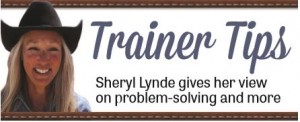 A client once brought a horse to me that had developed trailer-loading issues. It had endured an accident while being tied inside a trailer, and she had pulled back, resulting in minor injuries both physically and mentally. Subsequently, the owner had difficulty getting her into the trailer, and even once in, she would want out — and fast. She could fly backward.
A client once brought a horse to me that had developed trailer-loading issues. It had endured an accident while being tied inside a trailer, and she had pulled back, resulting in minor injuries both physically and mentally. Subsequently, the owner had difficulty getting her into the trailer, and even once in, she would want out — and fast. She could fly backward.
If you break it down, there are a couple of issues here. In addition to her anxiety while in the trailer, she also had an issue with pulling back. I’ll tackle Issue No. 1 first, which is her overall anxiety while inside the trailer. If I were able to eliminate her anxiety and help her to feel more at ease in the trailer, she would be less likely to pull back.
To start, I removed a panel from my round pen and then backed my trailer up to the opening until it was flush with the other panels. While standing inside the round pen facing the trailer door, I opened the door of the trailer to my right until it swung flush to a panel, where I secured it. To the left of the trailer opening, I pulled that round-pen panel, so it was even with the trailer and secured it there, leaving no spaces or unsafe edges between the panels and the opening of the trailer. I left the truck hitched to the trailer to make sure it remained stable while the horse loads and unloads.
After walking the horse through the gate into the round pen, I removed the halter and lead rope and began asking for outside turns only (nose to the rail) on the opposite end from the trailer. I was asking the horse to complete outside turns with energy, asking her to stay at a canter within the space of about five panels only. When I saw that she needed to rest, I would send her toward the opening of the trailer. It’s important that I would keep her facing the opening. If she didn’t want to rest and kept moving her feet, then I would oblige her and send her back to the opposite end of the round pen, asking for more outside turns.
I like asking the horse for outside turns – it teaches them to respect your space while turning away from you as well as how to use their hind ends. Outside turns are essentially rollbacks, so the correction is also training specific body parts.
As soon as I thought the mare was looking for a rest, again I would send her over to the trailer and ask her to face the opening. As long as she was facing the opening, I would let her rest. If she looked or wandered away, it was back to work. Once she understood that she can rest while facing the opening, her face would move closer and closer to the inside of the trailer.
At this point, since I was behind her, I began urging her forward into the trailer. If she jumped in, I would remain quiet and let her be for as long as she is in the trailer. If she jumped in but rushed out, then it’s back to work with the outside turns, as soon as her feet would hit the ground. I would send her back to the opening of the trailer often in order to offer a chance to rest. As soon as she jumped in the trailer, I would leave her be. Eventually, the mare jumped into the trailer and stood without a thought of coming out. I left the round pen and let her be. About 30 minutes later, I returned and she is still standing in the trailer — relaxed, rested and at ease.
That moment was a great time to work on the pullback issue, so I went into the trailer, haltered her, and backed her out slowly. As soon as her back feet hit the ground, I asked her to load back in and stand. After a minute, I’d repeat things until I could get her to stop and load again at any time, whether she was halfway or completely out. As soon as she felt the pressure of the halter at her pole and she yielded willingly and softly, I released immediately. This is the response I was looking for. I would make sure she has water in the round pen, remove the halter and lead, and let her be.
This lesson can be repeated as often as necessary. Her owner can now load her safely. Remember, it is always best to do your trailer-loading lesson when you can be relaxed without time constraints. Frustration ensues when your time is limited, or you have to load and trailer your horse due to an emergency. Be prepared!
~Sheryl
Leave a Comment
All fields must be filled in to leave a message.